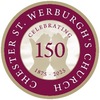St Werburgh's Catholic Parish, Chester

First Joyful Mystery: The Annunciation
Fruit of the Mystery: Humility
Mary learns that she will bear a child in the course of a visitation by an angel.
Luke 1:26-33 In the sixth month the angel Gabriel was sent by God to a town in Galilee called Nazareth, to a virgin betrothed to a man named Joseph, of the House of David; and the virgin's name was Mary. He went in and said to her, 'Rejoice, you who enjoy God's favour! The Lord is with you.' She was deeply disturbed by these words and asked herself what this greeting could mean, but the angel said to her, 'Mary, do not be afraid; you have won God's favour. Look! You are to conceive in your womb and bear a son, and you must name him Jesus. He will be great and will be called Son of the Most High. The Lord God will give him the throne of his ancestor David; he will rule over the House of Jacob for ever and his reign will have no end.'
The Angelus
The Angelus is a traditional Catholic devotion recalling the Annunciation. It is often prayed at three times during the day: at 6 am, noon, and at 6 pm. In many places the ringing of a Church bell accompanies the recitation of the Angelus, and often this practice helped to mark the passage of time in medieval and later communities.
V. The Angel of the Lord declared unto Mary.
R. And she conceived of the Holy Spirit.
Hail, Mary, full of grace, the Lord is with thee. Blessed art thou among women, and blessed is the fruit of thy womb, Jesus. Holy Mary, Mother of God, pray for us sinners, now and at the hour of our death. Amen.
V. Behold the handmaid of the Lord.
R. Be it done unto me according to thy word.
Hail Mary...
V. And the Word was made flesh.
R. And dwelt among us.
Hail Mary...
V. Pray for us, O holy Mother of God.
R. That we may be made worthy of the promises of Christ.
Let us pray. Pour forth, we beseech thee, O Lord, thy grace into our hearts; that we, to whom the Incarnation of Christ, thy Son, was made known by the message of an angel, may by his Passion and Cross be brought to the glory of his Resurrection. Through the same Christ, our Lord.
AMEN
The Window
At the top of the composition appears a dove, the sign of the Holy Spirit. It hovers above the head of the archangel Gabriel, who carries a banner on which is written Ave gratia plenae (Hail, full of grace). Mary, cloaked in blue, as she is most often represented, is seated at the foot of the angel and gazes upwards, her arms crossed in humility, and her head adorned with the luminous halo of sanctity.
The scroll in the bottom light reads: Fiat mihi secundum verbum tuum (let it me done unto me according to thy word), the answer Mary gives to the angel.
The inscription at the foot of the window reads: Orate pro animabus Gulielmi Broe qui obiit die 15a Jan. 1886 et Aliciae uxoris suae quae obiit die 5a Oct. 1925 (Pray for the souls of William Broe who died 15th January 1886 and his wife Alice who died 5th October 1925).
